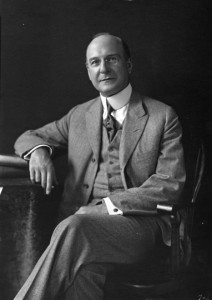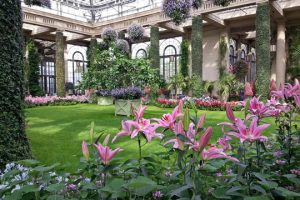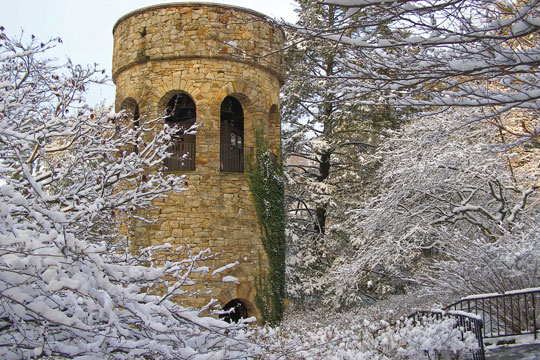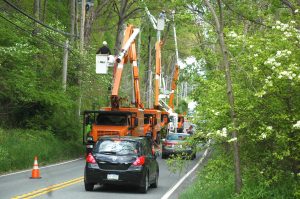Many people assume that highly renowned businessmen focus almost exclusively on one thing — the success of their business. Yet some of our nation’s great industrialists have aggressively pursued hobbies — one being the preservation of scenery near Kennett Square. After the turn of the 20th century, the famous entrepreneur Pierre du Pont purchased a local farm to save an old grove of trees for posterity, spawning a passion for horticulture that evolved into one of our nation’s most beloved floral sanctuaries.

In 1700, George Peirce emigrated to Philadelphia from England and purchased 402 acres in Chester County, a portion of which was given to his daughter as a marriage gift. The remaining acreage was given to his son Joshua, who built a house and cleared the area to allow a working farm. Later, Joshua’s enterprising Quaker grandsons decided to start an arboretum. It covered 15 acres and included trees from North America, Europe and Asia. With wild tulip trees, cucumber magnolias, Kentucky coffee trees and hundreds of other varieties acquired in their travels and from nurseries around the country, the two men nurtured a collection that became well known to visitors in the area. When the farm later passed to George Washington Peirce, the acreage was maintained and amenities like croquet courts, summer houses and a rowing pond were added to increase its attractiveness to the public.
Despite his dedication, George’s heirs demonstrated little interest in maintaining the property and sold it. The acreage was later resold twice and the third buyer had plans to cut down all the trees to produce lumber for his sawmill. The possibility of losing this natural treasure caused 36-year-old Pierre du Pont to buy Peirce’s Woods along with additional nearby land totaling 202 acres for roughly $16,000 in 1906 to preserve it forever. This treasure became Longwood Gardens, the name change from Peirce’s Woods coming from its proximity to the Longwood Friends Meetinghouse.
Pierre’s worldwide travels to places like London’s Royal Botanic (Kew) Gardens and the Sydenham Crystal Palace as well as California, Florida, Hawaii, the Caribbean and South America generated ideas to develop this horticultural gem. Stops at dozens of chateaus in France and several Italian villas gave him different concepts for architectural design and development. Pierre actually had hands-on experience with plants — he’d owned a commercial florist business with seven greenhouses by the age of 28. He also knew a bit about landscaping and design, supervising the building of 150 houses and later heading up the team that built the Du Pont building in downtown Wilmington. He used this experience to eventually develop an immense tapestry of buildings, walking paths, fountains and gazebos amidst a huge assortment of plants, trees and shrubs unequaled in the western hemisphere.
Pierre’s initial project was laying out the property’s first true flower garden, a 600-foot long Garden Walk that was filled annuals, biennials and perennials. A 20-foot wide pool with the first fountain was built at the intersection of the main paths. Utilizing his experiences at the Villa d’Este outside Rome and the Villa Gori in Siena, Pierre built the Open Air Theatre and later hosted an elaborate garden party in 1914 that was a huge success. He also had the Longwood greenhouse built to grow vegetables, fruits and flowers. This was later greatly expanded into an enormous classically designed building 181 feet wide and 204 feet long with arched bronze-rimmed windows, the structure reminiscent of 19th century exhibition halls. Alongside were single-story structures connected to pavilions with their own heat, water and power supplied directly onsite. Visitors could see a huge assortment of locally grown fruit- apricots, peaches, figs, grapes, melons, pineapples and nectarines. There were even experimental plantings that included coffee, pomegranates and coconut palms maintained by eight full-time gardeners.

Over the ensuing years, Pierre wanted to entertain the public even more- so he had a full-scale concert hall and dozens of fountains constructed nearby. The concert hall and ballroom were perfect for his pipe organ (with 10,010 pipes ranging in size from ¼-inch to 32 feet in length). Later an Italian water garden and an expansion of the Open Air Theatre continued his dream of building a world-class complex that people could enjoy for decades to come. Subsequent improvements included hundreds of additional pools and fountains accompanied by ornate Old World sculptures imported from Italy, as well as an intricate lighting system with glass filters that allowed the fountain displays to take on a surreal look at night. Years later, these would be accompanied by music, creating a spectacular synchronized panorama
The expanded fountain complex was largely completed by the mid 1930s; this marked the end of major construction during Pierre’s lifetime. He’d clearly succeeded in attaining his goal to create “a place where I could entertain my friends.” Pierre was more than a visionary horticulturalist. He was also a major history buff, collecting and translating hundreds of family documents from French to English and compiling a family genealogy going back almost five centuries. In 1950, he even hosted a 150th anniversary celebration to commemorate his family’s arrival in the U.S. with a gala event which was a huge success including 632 family members and guests from around the world. Pierre’s work was done. On April 2, 1954, Mr. du Pont was recognized by the French government for his lifetime achievement and awarded the Cravate de Commandeur of the French Legion of Honor in a ceremony at Longwood. A few days later, he passed away… but his accomplishments will last forever, a testament to brilliant foresight, unending dedication — and a love of nature that has benefited mankind.
(Main photo: Chimes Tower at Longwood, courtesy of Gene Pisasale)
* Gene Pisasale is an author and lecturer based in Kennett Square. He’s authored eight books and conducts an historic lecture series focusing on topics related to the Philadelphia/mid-Atlantic region. His book “Abandoned Address- The Secret of Frick’s Lock” delves into the history of an abandoned ghost town in northeastern Chester County with ties to the Industrial Revolution and some of the greatest inventors of all time. His lecture series “Frick’s Lock to Du Pont- How the Industrial Revolution Saved America” highlights how inventors and companies like Du Pont contributed greatly to our economic survival. Gene’s books are available on www.Amazon.com. For more information, visit his Web site at www.GenePisasale.com or e-mail him at Gene@GenePisasale.com.
About Gene Pisasale
Gene Pisasale is an historian, author and lecturer based in Kennett Square, Pa. His eight books and historic lecture series focus on the history of the mid-Atlantic region. Gene’s latest book is Alexander Hamilton: Architect of the American Financial System, which delves into the life and many accomplishments of this important Founding Father who almost single-handedly transformed our nation from a bankrupt entity into the most successful country in the history of mankind. Gene’s books are available on www.Amazon.com. His website is www.GenePisasale.com; he can be reached at Gene@GenePisasale.com.




Comments